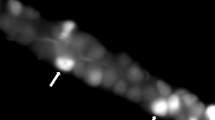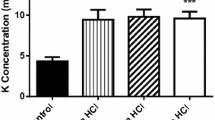Summary
The isolated cat pancreas was perfused with a Krebs-Henseleitsolution containing different concentrations of sulfamerazine buffer. Concomitantly the secretory rate, pH value, Cl− and total buffer concentration in the secretion were measured. The following were found:
-
1.
The secretory rate dropped to very small values when the bicarbonate buffer was omitted from the perfusate.
-
2.
Sulfamerazine can partly replace the CO2-bicarbonate buffer in promoting water and solute secretion in the saline-perfused preparation of the cat's pancreas.
-
3.
The secretion of the sulfamerazine buffer depended exclusively on the concentration of its undissociated component in the perfusate.
It is concluded that a separation of H+/OH− ions takes place presumably at the luminal cell border and that the undissociated form of sulfamerazine can penetrate the cell by ‘nonionic diffusion’. In this way a source of H+ ions is provided which may be used either for H+ transport or for the buffering of OH− ions. The process of nonionic diffusion seems to be rate limiting for the buffer secretion, at least when sulfamerazine is offered.
Similar content being viewed by others
References
Baumann, K., Oelert, H., Gekle, D.: pH-abhängige Resorption von schwachen organischen Säuren aus dem distalen Konvolut der Rattenniere. Pflügers Arch. ges. Physiol.283, R 25 (1965).
——, Sonnenberg, H.: pH-abhängige Diffusion organischer Substanzen im proximalen Konvolut der Rattenniere. In: Normale und pathologische Funktion des Nierentubulus. III. Sympos. Ges. f. Nephrologie, Berlin 1964. Bern: Huber 1965.
—, Peters, R., Papavassiliou, F.: Diffusion von Nichtelektrolyten und Berechnung von äquivalenten Porenradien im proximalen Konvolut der Rattenniere. Pflügers Arch. ges. Physiol.294, 21 (1967).
Beyer, K. H., Russo, H. F., Patch, E. A., Peters, L., Sprague, K. L.: The formation and excretion of acetylated sulfonamides. J. Lab. clin. Med.31, 65 (1946).
Birnbaum, D., Hollander, F.: Inhibition of pancreatic secretion by the carbonic anhydrase inhibitor 2-acetylamino-1,3,4-thiadiazole-5-sulfonamide, Diamox (6063). Amer. J. Physiol.174, 191–195 (1953).
——: Relation between bicarbonate concentration and rate of canine pancreatic secretion. Amer. J. Physiol.209, 966–972 (1965).
Bratton, C., Marshall, E. K., Jr.: A new coupling component for sulfanilamide determination. J. biol. Chem.128, 537 (1939).
Brodsky, W. A., Schilb, T. P.: Mechanism of acidification in turtle bladder. Fed. Proc.26, 1314–1321 (1967).
Case, R. M., Harper, A. A., Scratcherd, T.: The relationship between bicarbonate and chloride in pancreatic juice. J. Physiol. (Lond.)182, 49–50 P (1966).
———: Water and electrolyte secretion by the perfused pancreas of the cat. J. Physiol. (Lond.)196, 133–149 (1968).
———: The secretion of electrolytes and enzymes by the pancreas of the anaesthetized cat. J. Physiol. (Lond.)201, 335–348 (1969).
———: Water and electrolyte secretion by the pancreas. In: Exocrine Glands, Proc. of a Sattellite Symp. of the XXIV Intern. Congress of Physiol. Sciences, Ed. Bothelo, S. Y., F. P. Brooks and W. B. Shelly, pp. 39–56. Philadelphia: Univ. of Pensylvania Press 1969.
—, Scratcherd, T., Wynne, R. D. A.: The origin and secretion of pancreatic juice bicarbonate. J. Physiol. (Lond.)210, 1–15 (1970).
Christodoulopoulos, J. B., Jacobs, W. H., Klotz, A. P.: Action of secretin on pancreatic secretion. Amer. J. Physiol.201, 1020–1024 (1961).
Davies, R. E.: Doctoral Thesis. Sheffield: Univ. of Sheffield 1948.
Despopoulos, A., Callahan, P. X.: Molecular features of sulfonamide transport in renal excretory process. Amer. J. Physiol.203, 19 (1962).
—, Segerfeldt, A.: Efflux of organic acids from rabbit kidney cortex. Amer. J. Physiol.207, 118 (1964).
Dreiling, D. A., Janowitz, H. D.: The secretion of electrolytes by the human pancreas. The effect of Diamox, ACTH, and disease. Amer. J. dig. Dis.4, 137–144 (1959).
——, Halpern, M.: The effect of a carbonic anhydrase inhibitor, Diamox, on human pancreatic secretion. Gastroenterology29, 262–279 (1955).
Green, H. H., Steinmetz, P. R., Frazier, H. S.: Evidence for proton transport by turtle bladder in presence of ambient bicarbonate. Amer. J. Physiol.218, 845–850 (1970).
Grünhagen, H. H., Witt, H. T.: Primary ionic events in the functional membrane of photosynthesis. Z. Naturforsch.25b, 373–386 (1970).
Gutman, A. B., Yü, T. F., Sirota, J. H.: A study by simultaneous clearance techniques of salicylate excretion in man. Effect of alkalinization of the urine by bicarbonate administration, effect of probenecid. J. clin. Invest.34, 711 (1955).
Hart, W. M., Thomas, J. E.: Bicarbonate and chloride of pancreatic juice secreted in response to various stimuli. Gastroenterology4, 409–420 (1945).
Hollander, F., Birnbaum, D.: The role of carbonic anhydrase in pancreatic secretion. Trans. N. Y. Acad. Sci.15, 56–58 (1952).
Hubel, K. A.: In vitro rabbit pancreas: effect of temperature on HCO3 −, PCO2, pH, and flow. Amer. J. Physiol.212, 101–103 (1967).
Janowitz, H. D., Dreiling, D. A.: The pancreatic secretion of fluid and electrolytes. In: Ciba Found. Symp. The exocrine pancreas, Ed. de Reuck, A. V. S., and M. P. Cameron, pp. 115–133. London: Churchill 1962.
Knoefel, P. K.: Renal tubular transport of some nitro and amino hippuric acids. Proc. Soc. exp. Biol. (N. Y.)109, 148 (1962).
—, Huang, K. C., Jarboe, C. H.: Renal tubular transport and molecular structure in the acetamidobenzoic acids. J. Pharmacol. exp. Ther.134, 266 (1961).
———: Renal disposal of salicyluric acid. Amer. J. Physiol.203, 6 (1962).
Maren, T. H.: Carbonic anhydrase: chemistry, physiology, and inhibition. Physiol. Rev.47, 595 (1967).
Milne, M. D., Scribner, B. H., Crawford, M. A.: Non-ionic diffusion and the excretion of weak acids and bases. Amer. J. Med.24, 709 (1958).
Mitchell, P.: Chemiosmotic coupling in oxidative and photosynthetic phosphorylation. Printed Glynn Research Ltd. 1966.
Montal, M., Chance, B., Lee, C. P.: Ion transport and energy conservation in submitochondrial particles. J. Membrane Biol.2, 201–234 (1970).
Mudge, G. H., Weiner, I. M.: Renal excretion of weak organic acids and bases. Drugs and Membranes, Vol. 4, p. 157. Oxford-London-New York-Paris: Pergamon Press 1963.
Oelert, H., Baumann, K., Gekle, D.: Permeabilitätsmessungen einiger schwacher organischer Säuren aus dem distalen Konvolut der Rattenniere. Pflügers Arch.307, 178–189 (1969).
Pak, B. H., Hong, S. S., Pak, H. K., Hong, S. K.: Effects of acetazolamide and acid-base changes on biliary and pancreatic secretion. Amer. J. Physiol.210, 624–628 (1966).
Ramsay, J. A., Brown, R. H. J., Croghan, P. C.: Electrometric titration of chloride in small volumes. J. exp. Biol.32, 822 (1955).
Rawls, J. A., Jr., Wistrand, P. J., Maren, T. H.: Effects of acid-base changes and carbonic anhydrase inhibition on pancreatic secretion. Amer. J. Physiol.205, 651–657 (1963).
Ridderstap, A. S., Bonting, S. L.: The mechanism of exocrine pancreatic secretion. Fed. Proc.27, 834 (1968).
——: Na-K-activated adenosine triphosphatase and pancreatic secretion in the dog. Amer. J. Physiol.216, 547–553 (1969).
Rothman, S. S., Brooks, F. P.: Pancreatic secretion in vitro in “Cl−-free”, “CO2-free”, and low-Na+ environment. Amer. J. Physiol.209, 790–796 (1965).
Rumrich, G., Ullrich, K. J.: The minimum requirements for the maintenance of sodium chloride reabsorption in the proximal convolution of the mammalian kidney. J. Physiol. (Lond.)197, 69–70 P (1968).
Schulz, I., Ströver, F., Kasprik, B., Ullrich, K. J.: The action of bicarbonate-CO2-and glycodiazinebuffer on secretion in the cat pancreas. Pflügers Arch.319, R 92 (1970).
Schulz, I., Yamagata, A., Weske, M.: Micropuncture studies on the pancreas of the rabbit. Pflügers Arch.308, 277–290 (1969).
Solomon, A. K.: Symposium on secretion of electrolytes: Electrolyte secretion in pancreas. Fed. Proc.11, 722–731 (1952).
Sonnenberg, H., Baumann, K., Oelert, H.: pH-abhängiger Transport von Sulfamerazin und Harnsäure im proximalen Tubulus der Rattenniere. Pflügers Arch. ges. Physiol.279, R 27 (1964).
———: Nonionic diffusion in rat proximal tubule as a function of lipoid solubility. Physiologist7, 261 (1964).
—, Oelert, H., Baumann, K.: Proximal tubular reabsorption of some organic acids in the rat kidney in vivo. Pflügers Arch. ges. Physiol.286, 171 (1965).
Still, E. U., Bennet, A. L., Scott, V. B.: A study of the metabolic activity of the pancreas. Amer. J. Physiol.106, 509–523 (1933).
Struyvenberg, A., Morrison, R. B., Relman, A. S.: Acid-base behavior of separated canine renal tubule cells. Amer. J. Physiol.214, 1155–1162 (1968).
Swanson, C. H.: Micropuncture studies of the electrolyte secretion of the rabbit pancreas in vitro. Abstract: Third International Biophysics Congress of the International Union for Pure and Applied Biophysics, Cambridge, Mass. USA, August 29–September 3, 1969.
Ullrich, K. J., Rumrich, G., Radtke, H. W., Klöss, S.: Effect of bicarbonate and other lipid soluble buffers on the isotonic fluid absorption in the proximal tubule of the rat kidney. Pflügers Arch.319, R 72 (1970).
Way, L. W., Diamond, J. M.: The effect of secretin on electrical potential differences in the pancreatic duct. Biochim. biophys. Acta (Amst.)203, 298–307 (1970).
Weiner, I. M., Mudge, G. H.: Renal tubular mechanisms for excretion of organic acids and bases. Amer. J. Med.36, 743 (1964).
—, Washington II, J. A., Mudge, G. H.: On the mechanism of action of probenecid on renal tubular secretion. Bull. Johns Hopk. Hosp.106, 333 (1960).
Witt, H. T., Rumberg, B., Junge, W.: Electron transfer, field changes, proton translocation and phosphorylation in photosynthesis. Coupling in the thylacoid membrane. In: 19. Colloquium der Gesellschaft für Biologische Chemie. April 1968 in Mosbach/Baden, pp. 262–306. Berlin-Heidelberg-New York: Springer 1968.
Author information
Authors and Affiliations
Rights and permissions
About this article
Cite this article
Schulz, I., Ströver, F. & Ullrich, K.J. Lipid soluble weak organic acid buffers as “substrate” for pancreatic secretion. Pflugers Arch. 323, 121–140 (1971). https://doi.org/10.1007/BF00586444
Received:
Issue Date:
DOI: https://doi.org/10.1007/BF00586444




